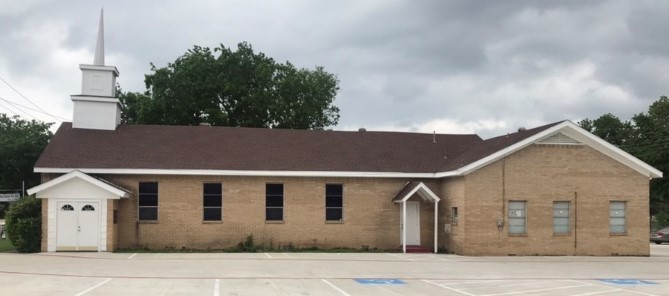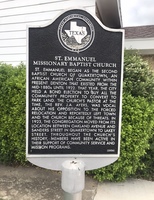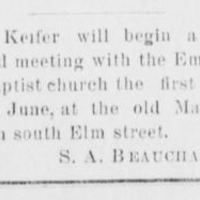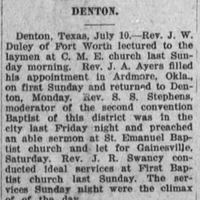St. Emmanuel Missionary Baptist Church
ST. EMMANUEL MISSIONARY BAPTIST CHURCH. St. Emmanuel Missionary Baptist Church, formally known as the Second Baptist Church of Quakertown was organized in 1906, at OldFellows Hall, in Denton’s African American community, Quakertown. This former African American middle-class neighborhood also consisted of other African American churches, including, Pleasant Grove Baptist Church and St. James AME Church. Rev. F. Scroggins became the first preacher of St. Emmanuel following the meeting at OldFellows Hall. Before the St. Emmanuel congregation constructed their first church building between 1906 and 1923, services were held at a tabernacle, which is a temporary primitive outdoor facility. Many African American churches organized after the Civil War usually held services in these types of structure before constructing their own church building. For instance, County Line Baptist in Pilot Point held their services in similar settings before constructing their first church building in 1874. Furthermore, St. James AME held services and church activities in members homes before constructing their first church in the 1880s.
African American churches in Denton County, including St. Emmanuel Baptist participated in events outside the immediate congregation. Although the Texas Historical Commission (THC) draft of the Texas Historical Marker for St. Emmanuel states that the church was organized in 1906; however, in 1896, the Denton County News reported a “meeting with the Emmanuel baptist church…at the old Masonic hall on south Elm Street.” If the Denton County News was referring to the same church as that was described in the THC, then St. Emmanuel Baptist may have organized at an earlier date. According to a Dallas Express article from 1919, Rev. Ayers, the preacher at St. Emmanuel Baptist conducted services at Ardmore, Oklahoma, which was one of his regular post’s. Preachers leading services outside their primary congregations was common during the late nineteenth and early twentieth centuries. Either way, few activities of St. Emmanuel are unknown before the 1920s.
By the 1920s, the future of St. Emmanuel Baptist and the rest of Quakertown seemed uncertain. By 1920, the campaign for Quakertown’s removal, led by white city officials and leaders was in full force. After Texas Woman’s University (TWU), formally known as College of Industrial Arts (CIA) opened their doors in 1903, white Dentonites and state officials became increasingly concerned with the proximity of the white women’s college to the black community of Quakertown. To solve this problem, leading white organizations and leaders in Denton passed a park bond that officially ordered Quakertown residents to sell their property to the city to construct a park. Many Quakertown residents relocated to Solman Hill, in the southeastern portion of Denton, where the current church of St. Emmanuel is located on Lakey Street.
Other African American churches, including Pleasant Grove Baptist Church and St. James AME Church were also forcibly relocated to southeast Denton. According to oral tradition, St. Emmanuel’s preacher during the Quakertown removal campaign, Rev. J.A. Ayers became critically outspoken about the removal campaign. Eventually serious threats against Ayers forced him to flee Quakertown.
Despite the forced relocation of St. Emmanuel Baptist from Quakertown, in 1923, African American churches in southeast Denton were still able to carry on with normal church functions and keep their relationships with other churches alive. For example, in 1924, preachers from St. Emmanuel, St. James AME, and churches from Pilot Point and Gainesville departed to the Ministerial Conference together, in Cowonsville, Texas. Decades later, St. Emmanuel Baptist still attended events held at County Line Baptist. Ms. Mary Jackson, a lifelong member of County Line Baptist Church recollects from her childhood that African American Baptist churches in the Denton County area, including St. Emmanuel Baptist and St. James Baptist Church in Pilot Point attended tent revivals hosted by County Line Baptist. As of 2018, Ms. Valerie Scott, another member of County Line Baptist, explains that members of County Line Baptist and St. Emmanuel Baptist still attend the same church events. For example, County Line Baptist plans to have the St. Emmanuel Baptist congregation attend their 155th Anniversary of the church’s founding this October.
Citations: Marvlous Gowans, “Historical Subject Marker of St. Emmanuel Missionary Baptist Church,” Texas Historical Commission (THC)” 2006;Meeting at masonic lodge found here: Denton County News. (Denton, Tex.), Vol. 5, No. 4, Ed. 1 Thursday, May 28, 1896, newspaper, May 28, 1896; Denton, Texas. (texashistory.unt.edu/ark:/67531/metapth504990/m1/8/?q=%22colored%22%20%22church%22:University of North Texas Libraries, The Portal to Texas History, texashistory.unt.edu; crediting Abilene Library Consortium; Gowans, “Historical Subject Marker of St. Emmanuel Missionary Baptist Church,” (THC), 2006;Chelsea Stallings, “Removing the Danger in a Business Way: The History and Memory of Quakertown, Denton, Texas,” (maters thesis University of North Texas, 2015), 3; Marvlous Gowans, “Historical Subject Marker of St. Emmanual Missionary Baptist,” (THC), 2006. https://apps.dentoncounty.com/website/historicalmarkers/PDFs/St-Emmanuel-Missionary-Baptist-Church.pdf;The Dallas Express (Dallas, Tex.), Vol. 32, No. 4, Ed. 1 Saturday, December 20, 1924, newspaper, December 20, 1924; Dallas, Texas.(texashistory.unt.edu/ark:/67531/metapth278522/m1/2/?q=%22Lane%20Chapel%22:University of North Texas Libraries, The Portal to Texas History, texashistory.unt.edu;Mary Jackson, Interview by Sarah Cunningham, UNT Oral History, Pilot Point, Texas, April 26, 2018; Valerie Scott, Interview by Sarah Cunningham, UNT Oral History, Pilot Point, Texas, April 30, 2018.




